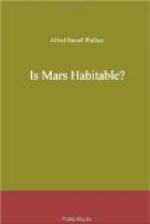[Footnote 9: For a short account of this remarkable instrument, see my Wonderful Century, new ed., pp. 143-145.]
(4) Then follows an elaborate estimate of the loss of heat during the passage of the sun’s rays through our atmosphere from experiments made at different altitudes and from the estimated reflective power of the various parts of the earth’s surface—rocks and soil, ocean, forest and snow—the final result being that three-fourths of the whole sun-heat is reflected back into space, forming our albedo, while only one-fourth is absorbed by the soil and goes to warm the air and determine our mean temperature.
(5) We now have another elaborate estimate of the comparative amounts of heat actually received by Mars and the Earth, dependent on their very different amounts of atmosphere, and this estimate depends almost wholly on the comparative albedoes, that of Mars, as observed by astronomers being 0.27, while ours has been estimated in a totally different way as being 0.75, whence he concludes that nearly three-fourths of the sun-heat that Mars receives reaches the surface and determines its temperature, while we get only one-fourth of our total amount. Then by applying Stefan’s law, that the radiation is as the 4th power of the surface temperature, he reaches the final result that the actual heating power at the surface of Mars is considerably more than on the Earth, and would produce a mean temperature of 72 deg. F., if it were not for the greater conservative or blanketing power of our denser and more water-laden atmosphere. The difference produced by this latter fact he minimises by dwelling on the probability of a greater proportion of carbonic-acid gas and water-vapour in the Martian atmosphere, and thus brings down the mean temperature of Mars to 48 deg. F., which is almost exactly the same as that of the southern half of England. He has also, as the result of observations, reduced the probable density of the atmosphere of Mars to 2-1/2 inches of mercury, or only one-twelfth of that of the Earth.
Critical Remarks on Mr. Lowell’s Paper.
The last part of this paper, indicated under pars. 4 and 5, is the most elaborate, occupying eight pages, and it contains much that seems uncertain, if not erroneous. In particular, it seems very unlikely that under a clear sky over the whole earth we should only receive at the sea-level 0.23 of the solar rays which the earth intercepts (p. 167). These data largely depend on observations made in California and other parts of the southern United States, where the lower atmosphere is exceptionally dust-laden. Till we have similar observations made in the tropical forest-regions, which cover so large an area, and where the atmosphere is purified by frequent rains, and also on the prairies and the great oceans, we cannot trust these very local observations for general conclusions affecting the whole earth. Later, in the same article (p. 170), Mr. Lowell says: “Clouds transmit approximately 20 per cent. of the heat reaching them: a clear sky at sea-level 60 per cent. As the sky is half the time cloudy the mean transmission is 35 per cent.” These statements seem incompatible with that quoted above.




